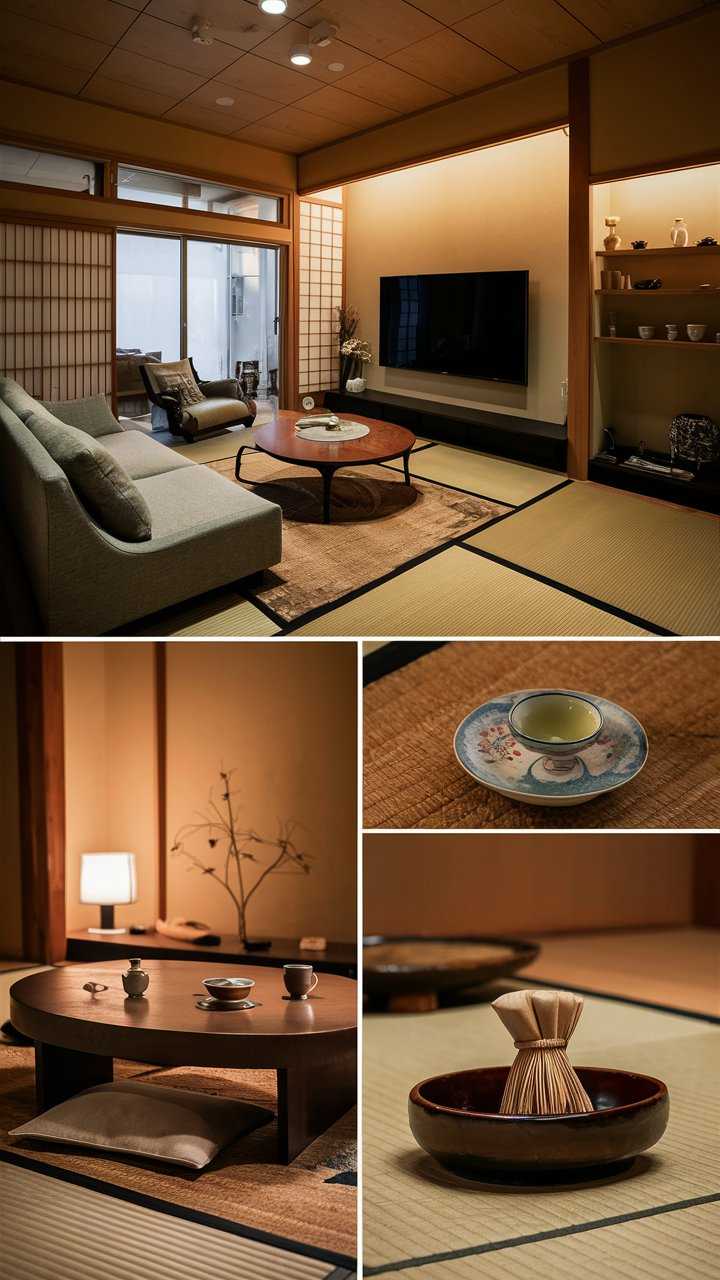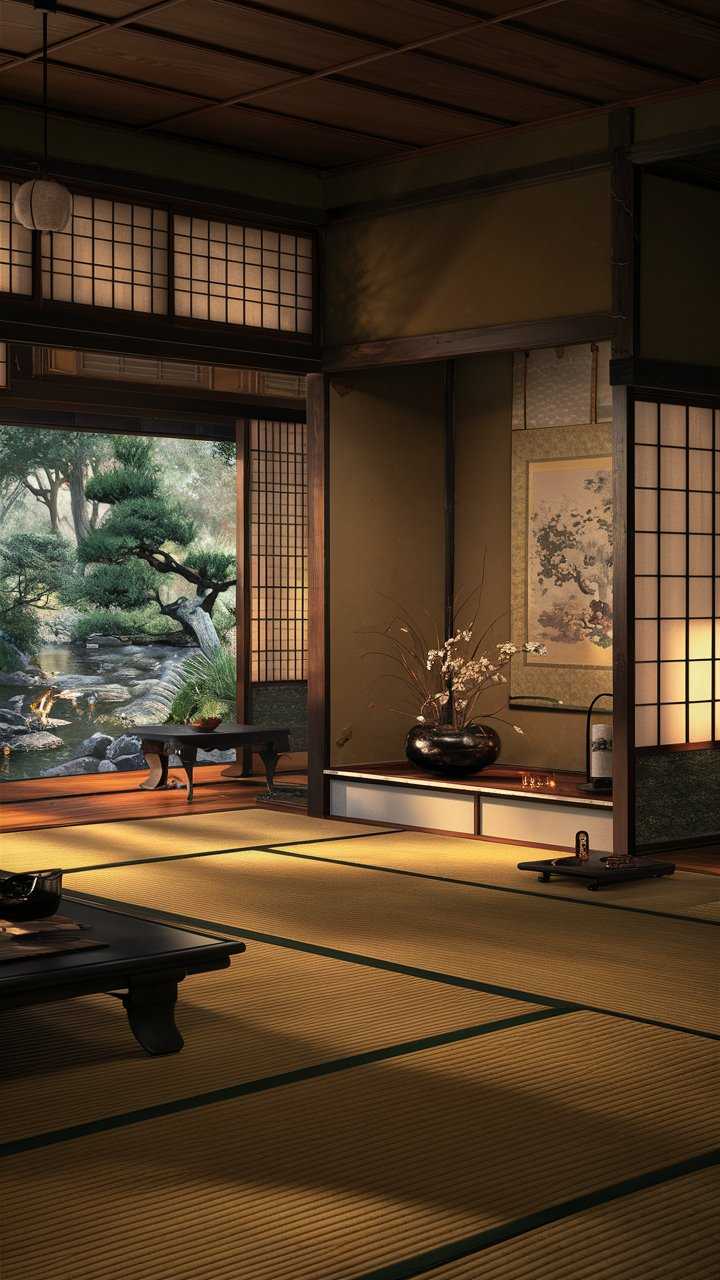Cozy Japanese Living Room Apartment Design Ideas
A cozy Japanese living room apartment is more than just stylish. It’s a place that blends traditional beauty with modern needs. In a world full of minimalism, Japanese design shines by creating calm spaces that help you relax and be mindful. This article will show you how to make your space peaceful with tatami mats, shoji screens, and zen decor.
We’ll also talk about adding ikebana flower arrangements, the importance of a tokonoma alcove, and the comfort of a kotatsu table. These ideas will help turn your space into a peaceful place. It’s perfect for those who love the simple beauty of a minimalist lifestyle.
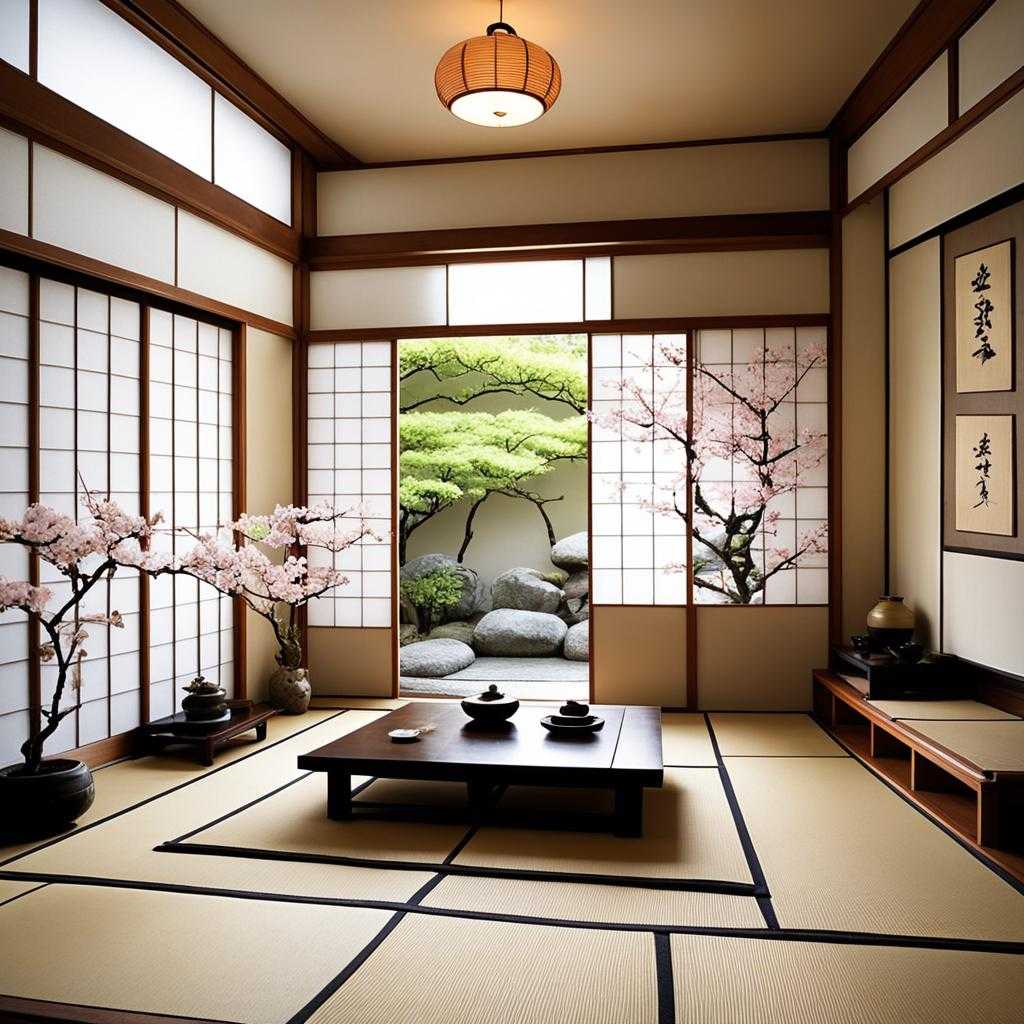
Key Takeaways
- Embrace minimalist living space principles through clean lines and uncluttered arrangements.
- Incorporate tatami mats for warmth and authenticity in your living area.
- Utilize shoji screens to create flexible room divisions while maintaining an open feel.
- Enhance your decor with zen principles to promote serenity and relaxation.
- Adorn your apartment with ikebana flower arrangements as a touch of natural elegance.
- Introduce a kotatsu table for comfort during colder months, fostering coziness.
- Implement fusuma sliding doors to maximize space efficiency in small apartments.
Understanding Japanese Interior Design
Japanese interior design combines simplicity with a love for nature. It’s all about minimalism and making things work well. Using neutral colors and natural materials, it makes spaces calm and perfect for relaxing.
The Philosophies of Minimalism and Functionality
Minimalism is key in Japanese interior design. It’s all about having open spaces and not too much stuff. Every piece of furniture has a purpose and looks good. This way, rooms are easy to move around in and feel peaceful.
Elements of Japanese Aesthetics
Japanese aesthetics include many important parts. These are:
- Simplicity: Clean lines and simple decor are a must.
- Natural Light: Lots of sunlight brings warmth and connects us to nature.
- Wabi-Sabi: Imperfections and things that don’t last forever are beautiful.
- Harmony and Balance: Making sure everything looks good together is key.
By using these elements, Japanese interior design changes living spaces for the better. It makes life better for those living in these spaces.
Creating a Cozy Atmosphere in Your Japanese Living Room Apartment
Creating a cozy atmosphere in a Japanese living room apartment is all about design. Use materials and colors that make you feel comfortable and calm. Soft textures and lots of natural light help make a space serene and welcoming, just like Japanese interior design.
Incorporating Soft Textures and Natural Light
Soft textures are key to a relaxing space. Cotton, wool, and natural fibers add a cozy feel. Natural light is also important, so arrange your furniture to let in as much as possible.
Use sheer curtains to let sunlight in while keeping your space private. This lets in light without losing privacy. It makes the room bright and peaceful.
Using Warm Color Palettes for Serenity
Warm colors like beige and soft greens bring peace to your space. These colors match well with nature, making your room feel connected to the outdoors. Choosing the right colors makes your living room cozy and calm.
Add wooden accents or decorative items to bring in more warmth and character. These touches are inspired by Japanese aesthetics, adding to the room’s charm.
Utilizing Tatami Mats for Authentic Japanese Charm
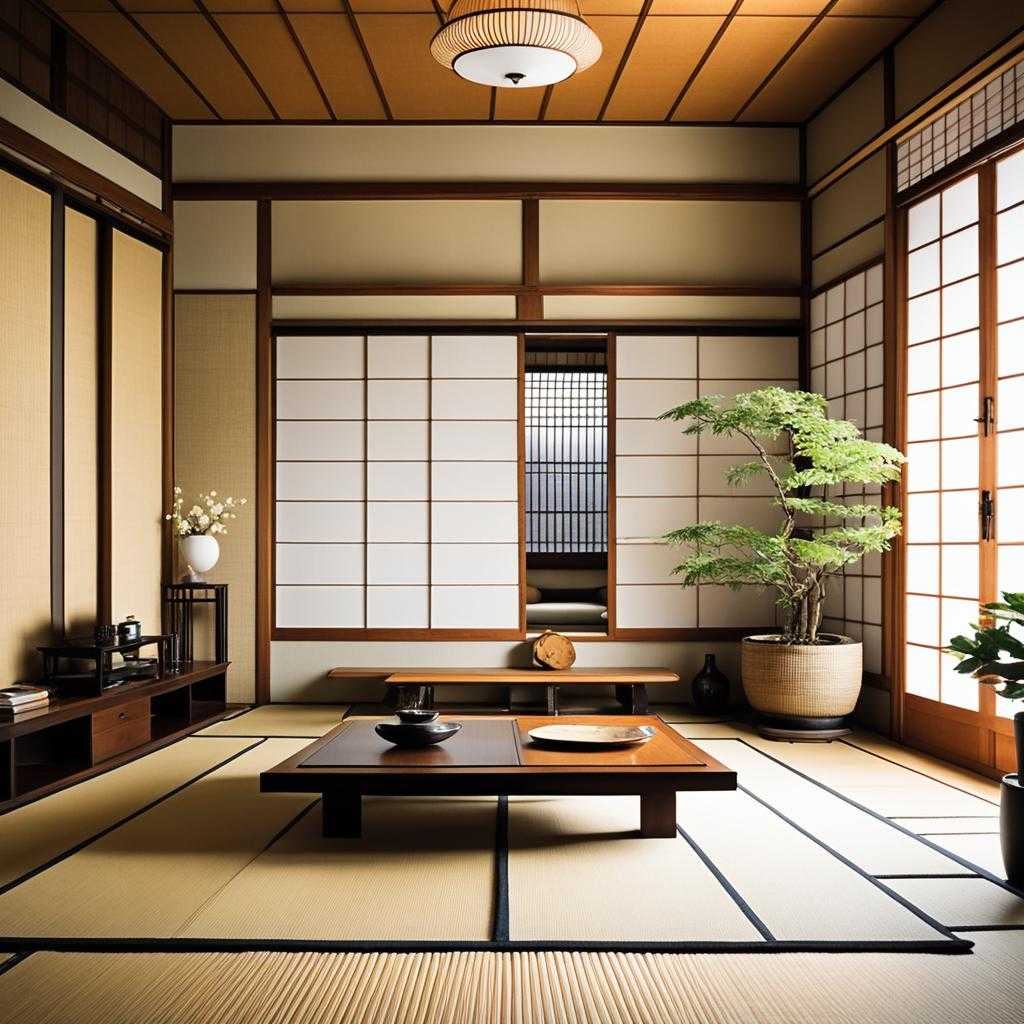
Tatami mats add a touch of authentic Japanese charm to modern homes. They are made from rice straw and rush grass. This makes them warm and inviting. They look great and offer practical benefits for today’s living.
Benefits of Tatami in Modern Living Spaces
Tatami mats are a favorite for those wanting to add traditional touches to their homes. They offer many advantages:
- Humidity Control: Tatami mats help keep humidity levels just right, making your home comfortable.
- Eco-Friendly: Being made from natural materials, they are good for the planet.
- Comfort: Their soft feel makes them great for sitting or relaxing.
- Insulation: Tatami keeps your room warm in winter and cool in summer.
Choosing the Right Tatami for Your Apartment
Choosing the right tatami is key for both looks and function in your apartment. Here are some tips:
| Aspect | Traditional Tatami | Modern Tatami |
|---|---|---|
| Dimensions | Standard sizes, customizable options available | Variety of sizes for contemporary needs |
| Material | Natural rice straw with woven rush grass | Synthetic options provided for easier maintenance |
| Appearance | Classic Japanese designs with authentic finishes | Stylish patterns appealing to modern tastes |
Adding tatami mats to your home brings tradition and modern living together. It’s a way to blend cultural heritage with today’s design trends. This creates a space that feels both timeless and contemporary.
Incorporating Shoji Screens for Versatility and Privacy
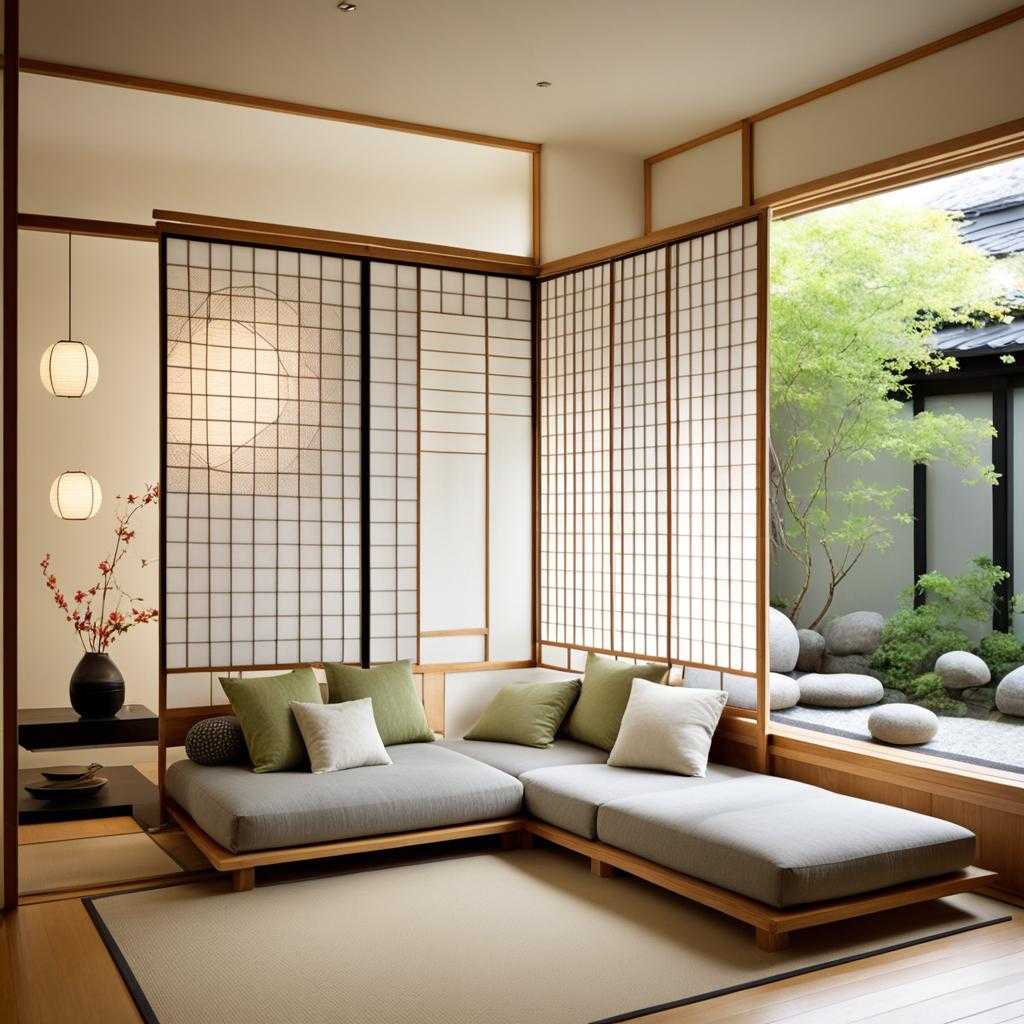
Shoji screens are great for any living space, blending function with style. They are versatile, perfect for many uses, and enhance privacy while letting light through. Knowing the types of shoji screens helps you pick the right one for your home, especially in small areas.
Types of Shoji Screens to Consider
- Fixed Panel Shoji Screens: Ideal for creating permanent divisions in rooms while still allowing light flow.
- Sliding Shoji Screens: Perfect for adapting to the layout of a space, offering flexibility to close off areas when needed.
- Folding Shoji Screens: Great for temporary setups, easily moved to create privacy as desired.
How to Effectively Use Shoji in Small Spaces
Adding shoji screens to small spaces makes them more functional without feeling cramped. Using a shoji screen as a divider can help separate areas, like a bedroom from a workspace. Here are some tips for using them well:
- Choose lightweight materials to maintain a sense of openness.
- Opt for screens with intricate designs to add visual interest without crowding the room.
- Utilize sliding shoji doors to expand flow and accessibility while preserving privacy.
| Type of Shoji Screen | Best Use | Privacy Level |
|---|---|---|
| Fixed Panel | Room dividers | High |
| Sliding | Flexible space separation | Medium |
| Folding | Temporary privacy | Adjustable |
Designing with Zen Decor in Mind
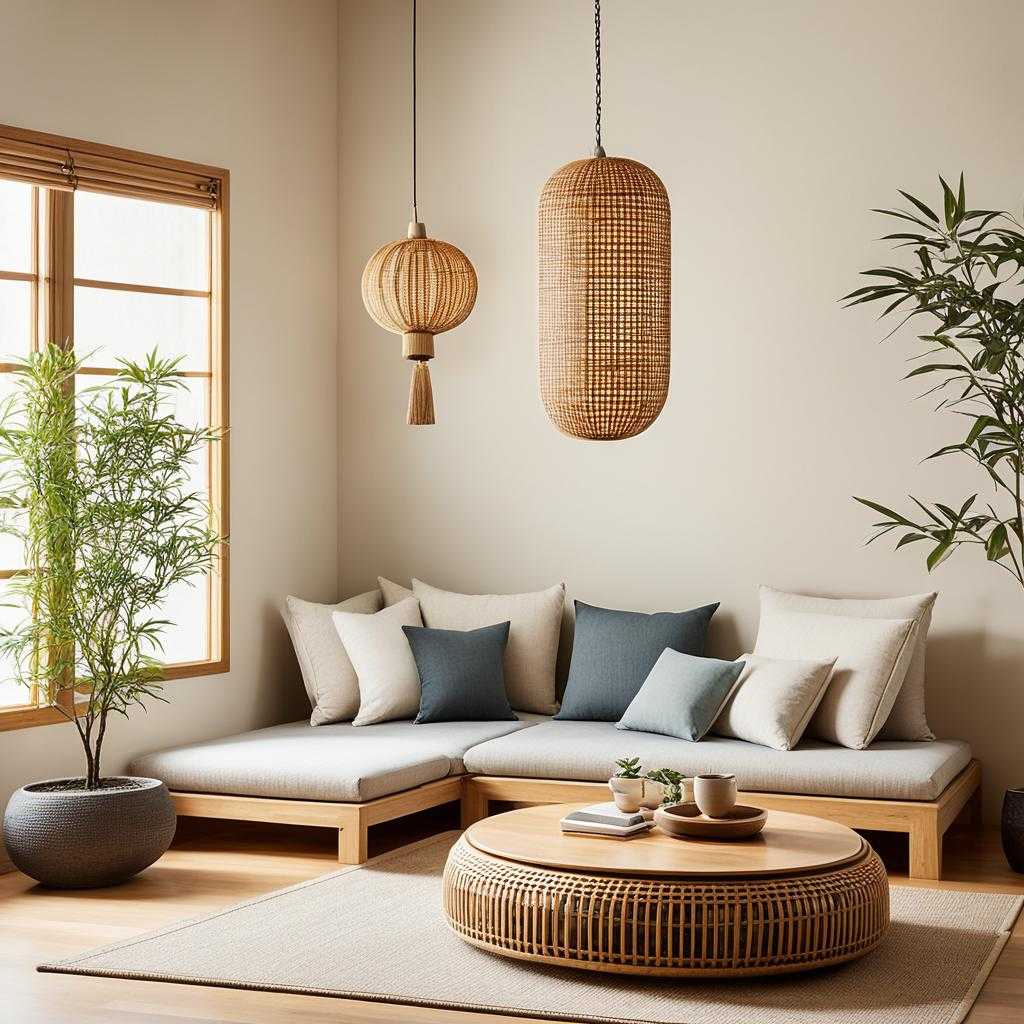
Creating a zen decor in your living space means focusing on tranquility and serenity. By adding elements that follow zen principles, you can turn your apartment into a peaceful retreat. This design is all about simplicity, using natural materials, and creating a calm atmosphere that encourages mindfulness.
Key Elements of Zen Decor
Zen decor is built around key elements that make a living space peaceful. These include:
- Natural Materials: Using wood, bamboo, and stone adds an organic feel.
- Simple Lines: Furniture and decor with clean lines reduce visual clutter.
- Neutral Color Palette: Soft colors like beige, gray, and white create calmness.
- Soft Textiles: Adding cushions and rugs brings warmth without overwhelming the senses.
Creating a Tranquil Space with Zen Principles
To make a space tranquil, focus on balance and harmony in your home. Consider these tips:
- Declutter: Remove unnecessary items for a minimalist look.
- Nature Integration: Add plants and natural light to connect with nature.
- Mindful Arrangement: Place furniture and decor thoughtfully for flow and openness.
By following zen principles, you create a space that promotes relaxation and mindfulness. These key elements can greatly improve your living experience.
Less is More: Embracing Minimalist Living Space
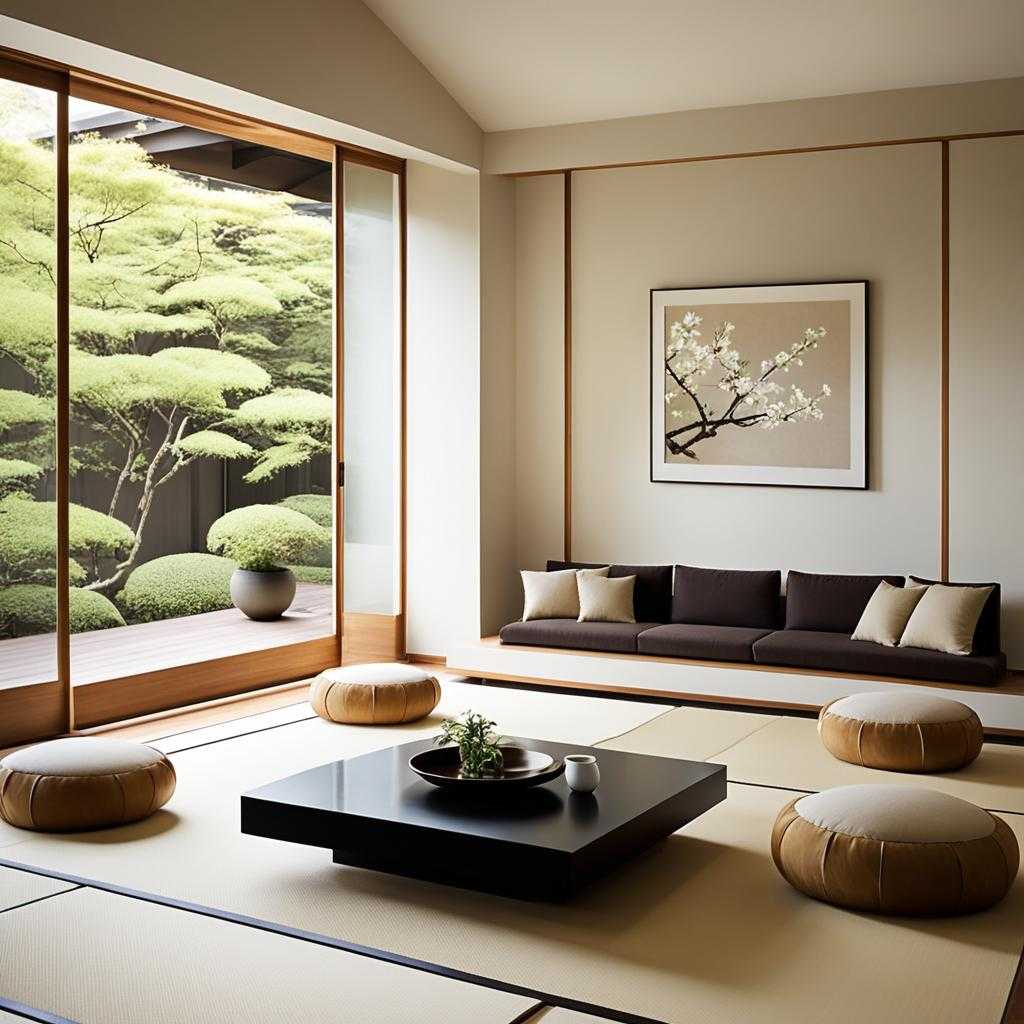
Embracing a minimalist living space is key in Japanese interior design. It makes the most of space and brings peace and clarity. A minimalist space shows the beauty of simplicity, promoting a life without too much stuff.
The Importance of Open Spaces and Decluttering
Open spaces are crucial for feeling free and letting in natural light. They make a home feel bigger and more connected to nature. This idea comes from the Japanese idea of living in harmony with nature.
Decluttering is key to a minimalist life. Having fewer items helps you focus and think clearly. A tidy home has fewer distractions, making it a peaceful place to live. Choose items that are useful and add value to your space, living peacefully.
Minimalism is more than just getting rid of things. It’s about living intentionally, where every item has a purpose. This way, any apartment can become a peaceful and balanced place.
Adding Ikebana Flower Arrangements for Natural Elegance
Ikebana flower arrangements add a unique charm and natural beauty to your home. They bring a sense of balance and simplicity. This makes your living room look more elegant.
Choosing the right flowers and placing them carefully are key to making ikebana stand out in your home.
Choosing the Right Flowers for Ikebana
It’s important to pick flowers that match the season. Traditional flowers like cherry blossoms, chrysanthemums, and lotus flowers are great choices. They add color and carry deep cultural meanings.
Each flower adds its own special touch to the arrangement. This makes the arrangement more meaningful and beautiful.
Placement Tips for Ikebana in Your Living Room
Where you place your ikebana arrangement is crucial. Look for spots that let you enjoy the arrangement without crowding your space. Good places include:
- On a small side table near seating areas
- In a dedicated corner with natural light
- On shelving or a console where they can shine without clutter
Following these tips makes it easy to move around your space. Your ikebana arrangements will enhance your decor and keep your home peaceful.
Incorporating a Tokonoma Alcove
A tokonoma alcove is a key part of Japanese interior design. It’s a special spot for showing off art and flowers. This alcove is more than just decoration. It brings balance, beauty, and peace into a room, letting you enjoy nature indoors.
What is a Tokonoma and its Significance?
In traditional Japanese homes, the tokonoma is a special alcove. It displays items like scrolls, pottery, or seasonal flowers. This spot encourages reflection, mixing beauty with function. It’s a cultural highlight, showing off Japanese art and heritage.
How to Design a Tokonoma in Your Apartment
When designing a tokonoma in your apartment, think about these points for a standout feature:
- Dimensions: Make sure the tokonoma fits well with your room’s layout.
- Artwork Selection: Pick art or ceramics that match your taste and the room’s theme.
- Seasonal Arrangement: Use seasonal decorations to celebrate nature all year round.
- Lighting: Use natural or soft artificial light to make the items look their best.
- Complementary Decor: Make sure the furniture and colors around the tokonoma enhance its look.
Adding a tokonoma alcove to your home adds cultural depth and beauty. It turns a simple corner into a place of art and peace.
The Comfort of a Kotatsu Table in Your Living Room
A kotatsu table is more than just furniture. It brings warmth and togetherness, perfect for cold seasons. The right size and design are key to making your living room cozy. It turns your space into a cozy spot for family time and relaxation.
Choosing the Right Kotatsu for Your Space
When picking a kotatsu for your living room, think about these things:
- Size: Make sure the kotatsu fits well in the space without taking over.
- Design: Pick a style that matches your decor, from traditional to modern.
- Heating Options: Decide between built-in heaters or electric ones for more warmth.
Benefits of a Kotatsu in Modern Living
There are many benefits to having a kotatsu table:
- Social Interaction: Kotatsu tables bring people together, helping to build strong bonds.
- Enhanced Warmth: The heating makes it super cozy during the cold months.
- Versatility: You can use your kotatsu for dining, coffee, or games, making it very useful.
Maximizing Space with Fusuma Sliding Doors
Fusuma sliding doors are a key part of Japanese design. They mix creativity with practicality. These doors make small apartments look better and use space well. They are more flexible than swinging doors, making the most of every inch.
Advantages of Sliding Doors in Small Apartments
For those living in the city, fusuma sliding doors are a big help. They offer many benefits, such as:
- Space efficiency: They save space by not needing room to swing open.
- Natural light: You can choose doors that let in sunlight, making rooms feel brighter.
- Versatile design: They come in many styles to match your home’s look.
- Room flexibility: You can easily change how a room is set up for different activities.
Design Tips for Fusuma Sliding Doors
Here are some tips to make the most of fusuma sliding doors:
- Choose the right materials: Pick wood, fabric, or paper that goes well with your decor.
- Incorporate patterns: Use traditional Japanese designs for a classic look or modern patterns for something new.
- Think about color: Light colors make rooms seem bigger, while dark colors add coziness.
- Focus on functionality: Make sure the doors slide easily to avoid wear and tear.
| Feature | Fusuma Sliding Doors | Traditional Swinging Doors |
|---|---|---|
| Space Usage | Maximized, no swing area required | Requires open space for swinging |
| Light Entry | Allows natural light flow | Limited light incidence when closed |
| Design Flexibility | High, various styles and materials | Moderate, limited to standard designs |
| Room Adaptability | Easy to reconfigure spaces | More difficult to manipulate room layouts |
Using fusuma sliding doors brings together culture, function, and beauty. They can change a space into a modern retreat. Whether you’re building a new home or updating an old one, these doors can help you make the most of every inch.
Conclusion
Creating a cozy Japanese living room means blending traditional Japanese elements with modern styles. Think tatami mats, shoji screens, and zen decor. These items make your living space look great and follow Japanese design principles of balance and harmony.
Minimalist ideas help make your space peaceful and healthy. Using natural materials and soft colors creates a calm vibe. This is key to a cozy Japanese living room feel.
Adding these design touches makes your space both useful and beautiful. It becomes a place that welcomes you and shows off your style. The end result is a peaceful spot that supports mindfulness and improves everyday life.
